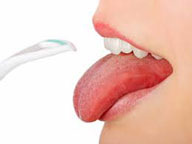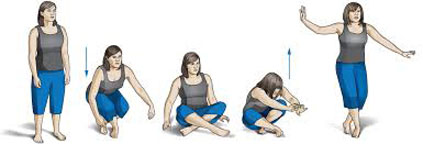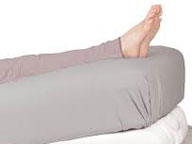Do it yourself
Six medical screenings you can do at home to make
this a healthy new year:
Your health is not something you should be taking for granted, but
doing simple health checks to ensure that everything is working as it
should, need not be an expensive procedure. In fact, you can start right
in your own home. Here NBC News' medical contributor Dr. Natalie Azar
explains six do-it-yourself health tests that take just one minute each.
However, keep in mind a positive result is just an indicator of a
symptom and doesn't necessarily mean you are sick.
 Clock
test for dementia Clock
test for dementia
• Draw a clock on a piece of paper, add the numbers in the right
order and make the hands point to 3:40. You get one point each for
drawing a closed circle, properly placed numbers, getting all 12 numbers
and properly placed hands. A score lower than four points could be a
cause for concern.
The test assesses cognitive functions like memory, problem solving
and executive functions like planning. "It's a good screening test for
early dementia," says Azar, explaining that studies have shown it's a
good predictor of cognitive health.
If a loved one doesn't do well on the test, get a screening for
dementia.
Bad breath test
 •
Scrape the back of your tongue with a spoon, seal the spoon in a plastic
bag and put it under a bright light for one minute. Then, smell it. •
Scrape the back of your tongue with a spoon, seal the spoon in a plastic
bag and put it under a bright light for one minute. Then, smell it.
• A healthy tongue coating should be clear, but if what you find on
the spoon is thick, coloured or has an unpleasant odour, it could be an
early sign of problems with your respiratory system, liver, kidneys,
hormones or gut.
• Most cases of bad breath will be related to gum disease or tonsils,
but really ominous odours could be a sign of a larger health problem.
Azar says a fruity smell could be a sign of diabetes; an ammonia smell
could be related to kidney problems, other smells could indicate gastric
or lung problems.
• And while you're at it, take note that this test is the closest
indicator of how your breath smells to other people.
Window test for eyes and vision loss
 •
Look at a door frame or large window frame from across a room where you
can see vertical and horizontal lines. Cover one eye and look at it for
30 seconds and repeat on the other side. •
Look at a door frame or large window frame from across a room where you
can see vertical and horizontal lines. Cover one eye and look at it for
30 seconds and repeat on the other side.
• You should be able to see the edges of the frame as vertical and
horizontal parallel lines without any wavy or missing parts. If the door
frame edges seem like they have kinks or are distorted, or bow in or
out, this may indicate that you have macular degeneration, one of the
most common causes of vision loss in people over 50.
Cross-legged squat test for agility and longevity
 •
Start off with 10 points. Cross your legs, squat down and sit down on
the floor; then get back up. If you don't use hands, feet or wobble at
all, you keep your 10 points. If any part of your body touches down, you
lose a point. •
Start off with 10 points. Cross your legs, squat down and sit down on
the floor; then get back up. If you don't use hands, feet or wobble at
all, you keep your 10 points. If any part of your body touches down, you
lose a point.
• Aim to score an 8 or higher in this test of muscle strength,
balance, flexibility and agility. How can this test predict longevity?
"According to researchers a couple of years ago, it did so with alarming
accuracy," says Azar, adding, "The lower your number, the greater
likelihood it is that you're going to die in the next six years."
Wobble test for faulty thyroid
 •
Stretch out your hand with your palm down, and place a piece of paper on
top of it. •
Stretch out your hand with your palm down, and place a piece of paper on
top of it.
• Look for trembling or shaking of the paper, which could be a sign
of hyperthyroidism.
• The condition, in which the thyroid is revved up and causes the
body's functions to go into hyperdrive, is more common in women, who are
four times more likely than men to have it.
• The movement could be too small to see on its own, but the paper
accentuates any shaking.
• Keep in mind, though, that a slight tremble is common, and can be
caused by caffeine, asthma medication, anxiety or low blood-sugar
levels.
Cushion test for artery problems Cushion test for artery problems
 •
Lie on your back on a bed and elevate both legs to a 45-degree angle on
cushions. Hold them there for one minute then quickly hang your legs
down over the side of the bed at 90 degrees. •
Lie on your back on a bed and elevate both legs to a 45-degree angle on
cushions. Hold them there for one minute then quickly hang your legs
down over the side of the bed at 90 degrees.
• If one or both of your feet or legs become very pale when elevated
but take several minutes to return to their regular color, it could be a
sign of peripheral arterial disease.
Risk factors for peripheral arterial disease, in which the arteries
that supply the leg muscles become narrowed, are high blood pressure,
high cholesterol and diabetes.
One caveat: This test can give a false positive in healthy people (it
could be sign of poor circulation linked to Raynaud's disease). Before
you worry about peripheral arterial disease, additional signs to look
for are cramping, pain and tiredness in the legs while walking or
climbing stairs. |

